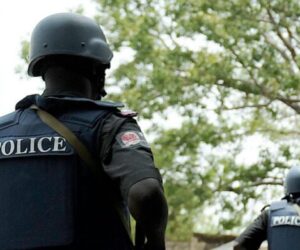On 20 October 2024, the police attacked a memorial gathering at Lekki Toll Gate, Lagos, held to honour victims of the shooting during the #EndSARS protest at the same location exactly four years earlier. In July this year, the Federal High Court in Lagos awarded N10 million in damages against the police for violating the rights of the participants by firing live ammunition and teargas at them.
Just two months after the judgment, the police again used force—this time against supporters of Kogi Central Senator Natasha Akpoti-Uduaghan at the National Assembly gate in Abuja. The crowd had arrived with Mrs Akpoti-Uduaghan in fanfare, celebrating her return to the Senate after a six-month suspension. But they fled in chaos and anguish as the police’s teargas canisters rained down.
Less than a month after the National Assembly gate scenario, the police, on Monday, 20 October, dispersed #FreeNnamdiKanu protesters with teargas at different locations in Abuja, despite the protests being peaceful.
From Lagos to Abuja and to other major Nigerian cities, firing teargas and live ammunition at crowds, particularly peaceful protesters, is commonplace. And it is hardly a surprise in a country where the police are associated with extrajudicial killings, causing serious injuries, illegal detention of innocent citizens, extortion, and enforced disappearance.
In the face of these serious transgressions, the routine use of teargas to break up protests is often overlooked. However, the regular breach reflects an entrenched culture of disregard for rules of engagement, democratic norms, citizens’ rights, and health, as well as a lack of accountability within the Nigerian police.
“Citizens should be worried when such protests are being discouraged or sought to be totally stopped through the police use of teargas and other injurious substances on protesters,” said Vincent Adodo, a lawyer.
According to him, protest is not only a fundamental right of citizens but also plays an important role in situations where other avenues, such as the courts, are ineffective.
“Not every decision that impacts negatively on the public can be challenged through the courts, given several legal impediments such as locus standi and the relatively long time it takes to decide matters in court,” the lawyer said.
“Thus, it is not expected of the police to use teargas canisters or other objects to scare away or intimidate protesters, as such conduct directly negates its statutory duty to provide security cover to protesters under section 83 (4) of the Nigeria Police Force (Establishment Act) 2020.”
Teargas, a stealth threat
Teargas is a form of chemical irritant used by law enforcement agents to produce sensory irritation and pain in its targets.
It is part of crowd-control weapons (CCWs) used in many countries. Its peers in the group include kinetic impact projectiles such as rubber bullets, water cannons, disorientation devices, acoustic weapons, and blunt force weapons.
Physicians for Human Rights (PHR), a not-for-profit organisation that investigates and campaigns against serious human rights abuses using medical and scientific expertise, explains that chemical irritants are generally seen as non-lethal and unlikely to cause lasting harm. Typically, these substances lead to effects like temporary tearing, eye irritation and pain, eyelid spasms, skin discomfort, breathing difficulties, and feelings of confusion or distress.
“This perception is now being challenged, with more evidence of associated moderate and permanent injuries as well as deaths,” an extensive report of investigations carried out by PHR and its partners said.
The report, ‘Lethal in Disguise’, released in March 2023, details “severe harms” to health and human rights resulting from protest abuses by law enforcement globally.
Noting that protests have surged across the globe in recent years over citizens’ discontent and demand for better deals from governments, the report put the number of those injured by chemical irritants during such demonstrations between 2015 and March 2023 at over 119,000.
Nigeria’s contribution to the figure is unknown, as there has been no comprehensive study on the use of chemical irritants against crowds in the country that focuses specifically on Nigeria.
But there is no doubt that the practice is pervasive in Nigeria.
“The firing of teargas at a peaceful protest has become so commonplace now that it looks like a ready-made forceful action that the police can take, for which they think they know that there is no clear legislation that condemns it,” said Hassan Soweto, an activist who was one of those victimised at the October 2024 #EndSARS memorial at Lekki Toll Gate.

Doctors warned in the wake of the August 2024 #EndBadGovernance protest against the dangers of indiscriminate use of teargas for protesters with underlying ailments.
During the #EndBadGovernance protest, which lasted 10 days, citizens in many states took to the streets to protest against poor governance and the high costs of living attributed to President Bola Tinubu’s economic policies.
The protest turned violent in Kano, where public and private properties were looted and destroyed, and the police were called in to quell the violence. Some youths in Kaduna also waved Russian flags and chanted slogans demanding the removal of President Bola Tinubu.
Generally, police treated peaceful protesters and the violent ones alike. During the demonstration in Abuja, the police attacked peaceful protesters, firing teargas at them around Eagle Square. The State Security Services (SSS) and the police shot rounds of live ammunition and teargas to disperse protesters and journalists covering the protest. Pellets of the bullets pockmarked the windscreen of one Sienna vehicle, while three bullets pierced the boot of a car conveying journalists deployed to cover the protests at Moshood Abiola Stadium. A female protester, overwhelmed by the teargas, collapsed on the ground of the stadium.
At another time during the days-long protest, the police fired teargas and live ammunition to disperse some youth who were protesting in the Galadimawa area of Abuja.
The conduct of the police, like the criminals who hid under the cover of the protest to commit crimes, ran counter to the elaborate advisory issued by the National Human Rights Commission (NHRC) ahead of the #EndBadGovernance demonstration.
The NHRC repeatedly cautioned security operatives against human rights abuses, emphasising the right to the freedom of association and assembly, adding that “Law enforcement agencies must respect citizens’ rights while maintaining public order without infringing upon constitutional freedoms.”
Similarly, civil society organisations such as Amnesty International Nigeria condemned the “reckless use of teargas” to disperse protesters.
These incidents continued a history of use of excessive force and unprofessional practices within the Nigerian police. In October 2020, widespread public frustration culminated in the nationwide #EndSARS protests against police brutality, prompting both federal and state governments to establish panels of inquiry to address and provide justice for victims of police misconduct over the years.
In November 2021, the report of the panel of inquiry set up by the Lagos State Government confirmed that security agencies, including the police, opened fire on a peaceful assembly during the #EndSARS protest, killing at least nine of the protesters.
In 2022, NHRC’s panel of inquiry set up in the aftermath of the 2020 #EndSARS protests confirmed many instances of crude and excessive use of force in police operations.
Catalogue of violations – Neglect of rights, laws, and rules of engagement
Local and international bodies, rights advocates and lawyers frame the abusive use of teargas against protesters as an act of cruelty and a direct attack on freedom of expression and assembly.
“Spraying teargas at peaceful protesters, bystanders, or so is a way of exposing them to cruel, inhumane, degrading treatment,” Comfort Kariko, a lawyer and team lead of Amplify It Initiative, told PREMIUM TIMES.

According to Ms Kariko, such an indiscriminate use of teargas contravenes Section 40 of the Nigerian constitution, which guarantees the right to peaceful assembly.
“The police do not have the liberty to disrupt a peaceful assembly except if it gets violent,” she said, as she also pointed to the Police Force Order that mandates the use of lethal force as a measure of last resort.
Mr Adodo also cited judicial precedents that have established citizens’ rights to protest. One such binding decision was delivered in the case of ANPP v. IGP (2003), where the Federal High Court in Abuja struck down provisions of the Public Order Act requiring citizens to obtain police permits before protesting.
In recognition of this right, the National Assembly in Abuja has an arcade where protesters and members of the public can assemble from time to time and express their views on the activities of the legislative body, emulating a thriving culture in advanced democracies worldwide.
However, on 23 September, the police officers attached to the complex flouted this principle.
They did not spare a crowd of supporters who merely accompanied Mrs Akpoti-Uduaghan to the National Assembly on her resumption from suspension. The event also highlighted how police can fail in a seemingly minor aspect: crowd control.

The senator’s supporters, comprising middle-aged women and young men from her constituency and human rights activists, followed by drummers and a vehicle with loudspeakers mounted on its roof, marched with her to the National Assembly from the FCT High Court in Maitama, where she had appeared for a criminal defamation case.
Some held placards with the inscription ‘WOMEN’S RIGHTS MUST BE PROTECTED’. Others waved the Nigerian flags, while others sang and danced to the rhythm of the beats.
The supporters roared with joy as they walked through the first gate of the National Assembly. A few supporters were allowed to proceed through the second gate. Then, a commotion ensued as law enforcement officers attempted to shut the gate abruptly. A woman stumbled and fell, and an officer assisted her to her feet.
As this transpired, police officers fired teargas to disperse the crowd. The resulting panic saw the supporters and journalists who were there to cover the senator’s resumption flee from the area. A reporter ducked, taking cover, and lamented her lack of an inhaler that she regularly used for a condition.
In June this year, the police dispersed the residents of Benue State protesting the insecurity in the state, which claimed the lives of more than 100 people in Yelwata town.
Acts of indiscriminate use of teargas by Nigerian police, like these, violate international standards and highlight deficiencies in their approach to managing public assemblies.
In 2017, worried that “the right to peaceful assembly is being severely tested” by “the attitude of law enforcement officials … during demonstrations” in African capitals, the African Commission on Human and Peoples’ Rights (ACHPR) issued the guidelines for policing assemblies on the continent, emphasising citizens’ rights to peaceful assembly and the need for protesters to respect other citizens’ rights.
The document states that the use of force “is an exceptional measure”, prescribing “non-violent methods before resorting to the use of force and firearms.”
“Force and firearms may only be used if other means of achieving a legitimate law enforcement objective are ineffective or unlikely to be successful. Law enforcement officials must, as far and for as long as possible, differentiate between peaceful assembly participants and those who engage in violent acts,” the guidelines stated.
More hazards for protesters
But contrary to domestic and international standards, peaceful protesters across Nigerian cities continue to suffer the use of force at the hands of the police. For many victims, the effect extends beyond fleeting moments of discomfort and irritation.
“Typically, in a crowd, you do not know the health conditions of people. There are people in that crowd who are asthmatic, who may have chronic lung disease,” Kutyyi Ango, a public health expert and pro-democracy campaigner, told PREMIUM TIES.
Ms Ango added, “The effect of teargas on those people is worse because it can trigger an asthmatic attack. And if that asthmatic attack is not well handled, say in situations where a person does not have their inhaler with them, it can just spiral to something really drastic.”
She described some of the effects as chest tightness, difficulty breathing, itchiness in the eyes, blurry vision, discomfort, and skin redness or rashes from direct contact.
Other neurological effects include headache, dizziness, and anxiety, which could lead to Post-Traumatic Stress Disorder (PTSD).
It could also lead to fainting. In the worst situations, it could lead to death, Ms Ango explained.
During the #FreeNnamdiKanu Now protest, a woman named Sulifa narrated how a man sustained a forehead injury as a result of the commotion that ensued when police indiscriminately fired teargas at a popular building material plaza in Jabi, Abuja.
Police spokesperson Benjamin Hundeyin confirmed on a live television programme in the wake of the demonstration the use of teargas against the protesters, but cast it as merely using “minimum force” to enforce a valid court order barring protests from certain locations. The protesters insisted that they had not been served the court order. But also, Jabi, where bystanders suffered physical injury and economic losses due to the police’s indiscriminate use of teargas, was not part of the restricted places listed in the widely reported court order.
Mr Hundeyin did not respond to PREMIUM TIMES’ request for his comments on the issues of legal violations, as well as rights abuses and health hazards that the indiscriminate use of teargas by the police constituted to protesters and bystanders.
The spokesperson for the police command in Abuja, Josephine Adeh, promised to send a written response to the same inquiries after our reporter honoured her invitation to her office. However, she has yet to send a response, despite repeated reminders via phone calls and text messages.
Misconceptions and way to go
A civil society organisation, Kimpact Development Initiative (KDI), pointed out in a publication that the hostile attitude of the police towards protesters is rooted in misconceptions that such gatherings constitute disruptions or threats to national security.
Mr Soweto advised that law enforcement officers must recognise that protest is a manifestation of the right to freedom of assembly, which is enshrined in the Nigerian Constitution.
He also emphasised the importance of dialogue with organisers of protest, which should not be centred on the restriction of their movement, echoing a key provision of the ACHPR’s policing assemblies guidelines on communication and engagement with protesters.
For him, attacking protesters sustains a cycle of distrust and hostility.
“When the police come to that kind of protest and they discharge weapons on people, they are doing more harm than good for the government they claim they have come to defend. Because by doing that, they are actually demonstrating to the people that peaceful protest does not work,” Mr Soweto said.
Similarly, Mr Soweto called for increased advocacy by civic groups, NGOs, unions, “to get the National Assembly to pass clear legislation that can further regulate the police and security agencies when it comes to the use of teargas.”
This lack of clarity demonstrates how the Nigerian police have, on several occasions, embraced teargas as a crowd control measure, despite the police directive mandating that sufficient warning is given to disperse assemblies only when there is an “imminent threat of death or serious injury, and less extreme measures are insufficient.’
The ‘Lethal in Disguise report’ maintained that “Respect for freedom of expression and assembly is one of the key indicators of a government’s respect for human rights, and a pillar of modern democracy. In the democratic system, governments are responsible for facilitating protests and ensuring that demonstrators can safely enjoy this fundamental right.”











